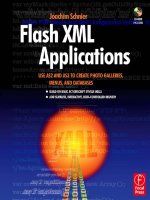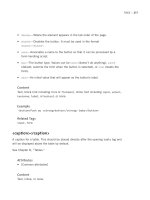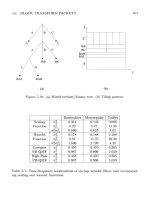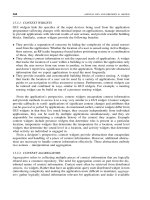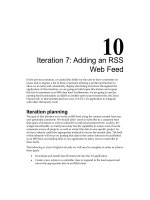Flash XML Applications Use AS2 and AS3 to Create Photo Galleries, Menus, and Databases phần 8 potx
Bạn đang xem bản rút gọn của tài liệu. Xem và tải ngay bản đầy đủ của tài liệu tại đây (550.32 KB, 33 trang )
mouse events. In AS2 or AS1 if a MovieClip with button functions or a button had a child, which also
had button functions, it was not possible to handle the event of the child. Only the event of the par-
ent was handled. In AS3 it is now possible to separate parent from child events. Because of this there is
a phenomenon known as event bubbling. That means that the event from the child bubbles to the par-
ent. A mouse event of the child will also result in a mouse event of the parent. This can sometimes be
useful and later there will be an example in which this is demonstrated. However, fortunately we can
also separate the events, so that the parent will not listen to the child event handler.
We will now get to an example, which describes a button function associated with a MovieClip. We
create a simple MovieClip and associate this MovieClip with the Starter_6 class when we establish
linkage. We place an instance of this MovieClip on the stage but avoid naming it. The main function
of this button MovieClip is to load a TextField and change the text content depending on the mouse
event. We first need to import several classes, among which is the flash.events.MouseEvent class.
package
{
import flash.display.MovieClip;
import flash.text.TextField;
import flash.events.MouseEvent;
public class Starter_6 extends MovieClip
{
private var tField:TextField;
public function Starter_6 ()
{
In AS3 the mouse icon is not automatically shown when the cursor is over the button area.
Therefore, we need to signal the player that the object will have buttonMode:
this.buttonMode = true;
We create an instance of a TextField and position it. All objects are created with the “new” oper-
ator. Also note that properties are no longer written with an underscore (for example, _x). This
was already introduced with Flash 8 components.
tField = new TextField();
this.tField.x = 50;
this.tField.y = 10;
The TextField will be a child of the button MovieClip and will react strangely to any Mouse-over
event. To prevent this we disable any event caused by the mouse:
this.tField.mouseEnabled = false;
myTest();
}
The main function contains all the event listeners. Unlike in AS2 in which we use the “Object.
eventhandler = function ( )” syntax, in AS3 we use only event listeners for all events. We specify
the event class, for example, MouseEvent, followed by the event type, which is a constant such as
Flash XML Applications
220
Ch16-K80917.qxd 8/16/07 3:26 PM Page 220
MOUSE_OVER. Then the name of the event-handler function follows. The second argument is
the name of the function, which can be any name. However, it is reasonable to give a name that iden-
tifies the event:
private function myTest():void
{
this.addEventListener (MouseEvent.MOUSE_UP,
mouseUpHandler);
this.addEventListener (MouseEvent.MOUSE_OUT,
mouseOutHandler);
this.addEventListener (MouseEvent.MOUSE_OVER,
mouseOverHandler);
this.addEventListener (MouseEvent.MOUSE_DOWN,
mouseDownHandler);
}
Then we write the individual functions. We have to add one function argument, for example,
“event”, which has the data type MouseEvent, to the event-handler function. When the mouse
moves over the button, we will actually place the TextField instance into the MovieClip and add
text. In all other functions we change the text.
private function
mouseOverHandler(event:MouseEvent):void
{
this.tField.text = "over"
this.addChild(tField);
}
private function mouseUpHandler(event:MouseEvent):void
{
this.tField.text = "up"
}
private function mouseDownHandler(event:MouseEvent):void
{
this.tField.text = "down"
}
Only when the mouse moves out from the button area do we remove the TextField instance using
the removeChild( ) method:
private function mouseOutHandler(event:MouseEvent):void
{
this.removeChild(tField);
}
}
}
Chapter 16: ActionScript 3: Basic Tutorial
221
Ch16-K80917.qxd 8/16/07 3:26 PM Page 221
This concludes this little tutorial. In the next chapters we will learn other event handlers and go
into more detail.
Namespaces
Our next tutorial will be more complex. We will combine what we have learned so far to create a
simple application. However, as the title of this section says, we will also learn a new feature intro-
duced with AS3, the namespace. In short, namespaces are variables that hold properties or func-
tions and hide them until they are called. We have learned about namespaces in connection with
XML. There is a connection if we look at the syntax, how a namespace can be referenced (see
below). The namespace usage is similar to the override attribute usage, in the sense that one vari-
able or method can replace another. An alternative to both could be, for example, to write a sub-
class with a different function. However, namespaces provide an easy way to have properties, values
or functions ready when they are needed without writing and calling another class. We are already
acquainted with attributes, which are predefined namespaces such as public, private, internal, and
protected.
In the following example we will use the namespace to replace functions in a mouse–button event.
The public class of the package contains the mouse event functions. There are two more classes,
which draw and create button objects from scratch. Therefore, the movie library is completely
empty, since all objects are created at runtime. We start with importing classes and declaring
variables.
package
{
import flash.display.Sprite;
import flash.text.TextField;
import flash.events.MouseEvent;
public class Starter_7 extends Sprite
{
private var button:CustomSimpleButton;
public var aField:TextField;
public var bField:TextField;
private var myIndex_a:Number;
private var myIndex_b:Number;
private var myIndex_c:Number;
While all other variables are kind of familiar to us, except for variables with unfamiliar data types,
we have not seen namespace variables so far. They have an attribute, such as public, followed
by the word “namespace” and the variable name, which in this case is the indicator name of the
function.
public namespace Test_1;
public namespace Test_2;
Flash XML Applications
222
Ch16-K80917.qxd 8/16/07 3:26 PM Page 222
In the same place where we declare the variables, we also write their values. In this case the values
are complete functions. We write the variable name followed by the variable value:
Test_1 function test_1 ():void
{
aField = new TextField ();
aField.text = "This is test 1.";
addChild(aField);
if(bField!=null)
{
removeChild(bField);
}
}
Test_2 function test_2 ():void
{
bField = new TextField ();
bField.text = "This is test 2.";
addChild(bField);
if(aField!=null)
{
removeChild(aField);
}
}
We can write the constructor and the main function of this class:
public function Starter_7 ()
{
myTest();
}
private function myTest():void
{
Let’s go through this script, so you can learn some more AS3 syntax, which is useful and gets you
familiar with the code. We create a button, again using the “new” operator. The class itself is
described below. We place the button and add event handlers to the button instances:
button = new CustomSimpleButton();
button.x = 100;
button.y = 100;
button.addEventListener(MouseEvent.MOUSE_OUT,
mouseOutHandler);
button.addEventListener(MouseEvent.MOUSE_OVER,
mouseOverHandler);
addChild(button);
}
Chapter 16: ActionScript 3: Basic Tutorial
223
Ch16-K80917.qxd 8/16/07 3:26 PM Page 223
Now when we write the functions for the button event handlers we call the namespaces. There are
two ways to do that:
private function mouseOutHandler(event:MouseEvent):void
{
We use the word “use” followed by namespace and the variable name. We then need to add the
actual function name itself:
use namespace Test_1;
test_1 ();
}
private function mouseOverHandler(event:MouseEvent):void
{
The second way is simpler. We write the variable name followed by “::” and the function name.
This is similar but not identical to XML documents with namespaces (Chapter 3).
Test_2::test_2 ();
}
}
}
The above script would not do anything if we did not code for any objects now. This is also a good
example of the use of additional classes within a file. The following classes are a kind of auxiliary
class.
We import classes. Most of these are not familiar to us, such as the Shape or the SimpleButton class.
However, the names tell us what they are made for. In the first class, CustomSimpleButton, we
create a button. In the second class, ButtonDisplayState, we create the actual shape of the button.
One could say that the second class is an auxiliary class for the CustomSimpleButton class.
import flash.display.DisplayObject;
import flash.display.Shape;
import flash.display.SimpleButton;
First we create a button using the SimpleButton class. We add variables to change the color of the
button in the different states. We use the new uint data type.
class CustomSimpleButton extends SimpleButton
{
private var upColor:uint = 0xFFCC00;
private var overColor:uint = 0xCCFF00;
private var downColor:uint = 0x00CCFF;
private var size:uint = 80;
We now determine the properties of the button at the different button states. The variables
“downstate”, “overstate”, “upstate”, “hitTestState”, and “useHandCursor” are properties of the
Flash XML Applications
224
Ch16-K80917.qxd 8/16/07 3:26 PM Page 224
SimpleButton class. We create an instance of the ButtonDisplayState class for each of the button
states and change color and (if we want) size as well:
public function CustomSimpleButton ()
{
downstate = new ButtonDisplayState(downColor, size);
overstate = new ButtonDisplayState(overColor, size);
upstate = new ButtonDisplayState(upColor, size);
hitTestState = new ButtonDisplayState(upColor, size);
hitTestState.x = hitTestState.y = (size/4);
useHandCursor = true;
}
}
The ButtonDisplayState class is a subclass of the Shape class. The main function is “draw()”, which
will draw a rectangle shape, in our case, with color and of a certain size every time, when the but-
ton is pressed.
class ButtonDisplayState extends Shape
{
private var bgColor:uint;
private var size:uint;
public function ButtonDisplayState(bgColor:uint,
size:uint)
{
this.bgColor = bgColor;
this.size = size;
draw();
}
private function draw():void
{
graphics.beginFill(bgColor);
graphics.drawRect(0, 0, size, size);
graphics.endFill();
}
}
When you now test the movie, there will be a button, and in its over and out state the color will
change and, of course, because of the namespaces, the text in the TextField will change. This brings
us to the end of the AS3 introductory tutorial. We will cover other aspects, in particular XML or
advanced topics, in the next chapters.
Chapter 16: ActionScript 3: Basic Tutorial
225
Ch16-K80917.qxd 8/16/07 3:26 PM Page 225
17
XMLDocument, XMLNode,
XML, and XMLList Classes
Overview
In this chapter all the properties and methods of the existing XML-related classes are shown with
examples. For all examples there are working files in the Chapter 17 folder, in the corresponding
subfolders. As in the AS2 section we also develop an XML file loading class, which can be called
whenever we need to load an XML file. This loading class also has another function, with which we
can load images and movies. We use this class for all the examples and later tutorials, since
we do not want to rewrite the loading code over and over again. This makes our scripts simpler and
easier to read. This class can also be used to call XML files from an external domain using
the proxy method. This class will be the tutorial of this chapter after all the XML classes have been
introduced.
In AS3, new classes that are related to XML have been added. The former XML class still exists but
has been renamed the XMLDocument class. We will not repeat all the examples of this class in this
chapter but only mention the properties and methods. Examples are in the subfolder XMLDocument.
The first new class is the XML class, which now has methods to access nodes, attributes, etc.,
directly and modify them. This makes long code statements like those we have seen in the AS2 sec-
tion, such as “firstChild.nextSibling.…”, unnecessary. The DOM (document object model) array
properties of an XML file are now fully exploited. XML parsing in AS3 is now adjusted to
ECMAScript for XML (E4X), which was standardized as ECMA-357. A third class is the XMLList
class. This class uses some of the methods of the XML class. An XMLList object is any XML data
or “fragment”. If the object has one element, all methods, as for the XML object, are available. For
methods of both classes there will be example code shown and there are example files in the sub-
folders XML and XMLList. A full description of all methods and properties can also be found in
the Flash Help files.
Full Example Code
The following example shows the whole class script, which is used for all examples. When the indi-
vidual properties and methods are discussed only the final part of the code within the “loadParse”
function is shown. The following example is for the attribute method. We import the Sprite, Event,
and LoaderClass classes, the last of which contains a method to load XML. When we parse XML
the old-fashioned way, we need to import the XMLDocument class. We do not need to import the
XML class, which is a final class.
226
Ch17-K80917.qxd 8/16/07 3:27 PM Page 226
package
{
import flash.display.Sprite;
import flash.events.Event;
//import flash.xml.*;
import scripts.helper.LoaderClass;
We declare the public class and extend it to the Sprite class. We need only one main variable for a
LoaderClass object.
public class Attribute extends Sprite
{
private var pXml:LoaderClass;
public function Attribute ()
{
}
There is one main public function, which we call from the movie, which has one argument, the
path and name of the XML file. We then create a new LoaderClass object and call its main func-
tion “initXML”, with two arguments, for the name of the XML file and the name of the function,
which will be called after the XML data is reloaded.
public function parseData (xmlFile:String):void
{
pXml = new LoaderClass ();
pXml.init (xmlFile, loadParse);
}
When the XML file is loaded, the function “loadParse” is initiated. We then create either an
XMLDocument object or an XML object as shown here. Then class-specific code follows for the
attribute method shown here:
private function loadParse (event:Event):void
{
The part from here on will be shown as the class-specific code for the examples:
var xmlData:XML = XML(event.target.data);
trace(xmlData.house[1].attribute("id"));
trace(xmlData.house[1].built);
trace(xmlData.house.(@id = = 2).built);
trace(xmlData.house.(built = = 1982).image);
}
}
}
Chapter 17: XMLDocument, XMLNode, XML, and XMLList Classes
227
Ch17-K80917.qxd 8/16/07 3:27 PM Page 227
Flash XML Applications
228
When we want to work with the XMLNode or XMLDocument class we need to write a few more
lines within the function “loadParse”. We need to eliminate white space and parse the XML:
private function loadParse (event:Event):void
{
var myXML:XMLDocument = new XMLDocument ();
myXML.ignoreWhite = true;
myXML.parseXML (event.target.data);
var node:XMLNode = myXML.firstChild.firstChild;
var myData:String = node.firstChild.attributes.
description;
trace(myData);
}
The XMLDocument Class
Properties
The XMLDocument class is identical with the former XML class. See Chapter 3 for definitions.
.fla files for every method and property can be found on the CD in the Chapter 17 folder.
docTypeDecl property
public var docTypeDecl:Object
Specifies information about the XML document’s DOCTYPE declaration.
idMap property
public var idMap:Object
An object containing the nodes of the XML that have an id attribute assigned.
ignoreWhite property
public var ignoreWhite:Boolean
When set to true, text nodes that contain only white space are discarded during the parsing process.
xmlDecl property
public var xmlDecl:Object
A string that specifies information about a document’s XML declaration.
Constructor detail: XMLDocument() constructor
public function XMLDocument(source:String)
Creates a new XMLDocument object.
Ch17-K80917.qxd 8/16/07 3:27 PM Page 228
Chapter 17: XMLDocument, XMLNode, XML, and XMLList Classes
229
Methods
createElement() method
public function createElement(name:String):XMLNode
Creates a new XMLNode object with the name specified in the parameter.
createTextNode() method
public function createTextNode(text:String):XMLNode
Creates a new XML text node with the specified text.
parseXML() method
public function parseXML(source:String):void
Parses the XML text specified in the value parameter and populates the specified XMLDocument
object with the resulting XML tree.
toString() method
public override function toString():String
Returns a string representation of the XML object.
XMLNode Class
The XMLNode class is the same as in AS2. Only the members and short description are summa-
rized here. For more details check Chapter 3. For AS3 examples of this class check the XMLNode
folder in the Chapter 17 folder.
Properties
attributes : Object
An object containing all of the attributes of the specified XMLNode instance.
childNodes : Array
[Read-only] An array of the specified XMLNode object’s children.
constructor : Object
A reference to the class object or constructor function for a given object instance.
firstChild : XMLNode
Evaluates the specified XMLDocument object and references the first child in the parent node’s
child list.
lastChild : XMLNode
An XMLNode value that references the last child in the node’s child list.
Ch17-K80917.qxd 8/16/07 3:27 PM Page 229
Flash XML Applications
230
localName : String
[Read-only] The local name portion of the XML node’s name.
namespaceURI : String
[Read-only] If the XML node has a prefix, namespaceURI is the value of the xmlns declaration for
that prefix (the URI), which is typically called the namespace URI.
nextSibling : XMLNode
An XMLNode value that references the next sibling in the parent node’s child list.
nodeName : String
A string representing the node name of the XMLNode object.
nodeType : uint
A nodeType constant value, either XMLNodeType.ELEMENT_NODE for an XML element or
XMLNodeType.TEXT_NODE for a text node.
nodeValue : String
The node value of the XMLDocument object.
parentNode : XMLNode
An XMLNode value that references the parent node of the specified XML object or returns null if
the node has no parent.
prefix : String
[Read-only] The prefix portion of the XML node name.
previousSibling : XMLNode
An XMLNode value that references the previous sibling in the parent node’s child list.
prototype : Object
[Static] A reference to the prototype object of a class or function object.
Public Methods
XMLNode(type:uint, value:String)
Creates a new XMLNode object.
appendChild(node:XMLNode):void
Appends the specified node to the XML object’s child list.
cloneNode(deep:Boolean):XMLNode
Constructs and returns a new XML node of the same type, name, value, and attributes as the
specified XML object.
Ch17-K80917.qxd 8/16/07 3:27 PM Page 230
Chapter 17: XMLDocument, XMLNode, XML, and XMLList Classes
231
getNamespaceForPrefix(prefix:String):String
Returns the namespace URI that is associated with the specified prefix for the node.
getPrefixForNamespace(ns:String):String
Returns the prefix that is associated with the specified namespace URI for the node.
hasChildNodes():Boolean
Indicates whether the specified XMLNode object has child nodes.
insertBefore(node:XMLNode, before:XMLNode):void
Inserts a new child node into the XML object’s child list, before the beforeNode node.
removeNode():void
Removes the specified XML object from its parent.
toString():String
Evaluates the specified XMLNode object; constructs a textual representation of the XML struc-
ture, including the node, children, and attributes; and returns the result as a string.
XML Class
The XML class is new in AS3 and allows direct access of nodes and attributes using the names. The
example code presented here is the one from the sample files. The following XML files were used
for the examples.
File 1
<?xml version = "1.0"?>
<!DOCTYPE house SYSTEM "house.dtd">
<RealEstate>
<house id = "1">
<bedroom description = "Bedroom:">3</bedroom>
<bath description = "Bath:">2</bath>
<price description = "Price:">239,999</price>
<built description = "Built in">1990</built>
<city description = "City:">North Sacramento</city>
<image description = "Image:">images/house1.jpg</image>
<details description = "Details:">null</details>
</house>
<house id = "2">
<bedroom description = "Bedroom:">2</bedroom>
<bath description = "Bath:">1</bath>
<price description = "Price:">139,999</price>
Ch17-K80917.qxd 8/16/07 3:27 PM Page 231
Flash XML Applications
232
<built description = "Built in">1982</built>
<city description = "City:">South Sacramento</city>
<image description = "Image:">images/noimage.
jpg</image>
<details description = "Details:">null</details>
</house>
File 2
<?xml version = "1.0"?>
<!DOCTYPE house SYSTEM "house.dtd">
<RealEstate>
<house id = "1">
<!— This house is in a beautiful area. >
<?xml-stylesheet href = "foo.xsl" type = "text/xml"
alternate = "yes"?>
<bedroom description = "Bedroom:">3</bedroom>
<bath description = "Bath:">2</bath>
<price description = "Price:">239,999</price>
<built description = "Built in">1982</built>
<city description = "City:">North Sacramento</city>
<image description = "Image:">images/house1.jpg</image>
<details description = "Details:">null</details>
</house>
</RealEstate>
File 3
<?xml version = "1.0" encoding = "UTF-8"?>
<hs:Agency xmlns:hs = "">
<hs:Body>
<hs:Built text = "Built in ">1990</hs:Built>
<hs:Location text = "Located in ">Sacramento</hs:
Location>
<hs:Price text = "Price: ">$239,000</hs:Price>
</hs:Body>
</hs:Agency>
Properties
ignoreComments property
ignoreComments:Boolean [read-write]
Ch17-K80917.qxd 8/16/07 3:27 PM Page 232
Chapter 17: XMLDocument, XMLNode, XML, and XMLList Classes
233
Determines whether XML comments are ignored when XML objects parse the source XML data.
By default, the comments are ignored (true). To include XML comments, set this property to false.
The ignoreComments property is used only during the XML parsing, not during the call to any
method such as myXMLObject.child(
∗
).toXMLString( ). If the source XML includes comment
nodes, they are kept or discarded during the XML parsing.
Example (file 2)
When set to false, all comments will be shown.
XML.ignoreComments = false;
var xmlData:XML = XML(event.target.data);
trace(xmlData);
Traces the entire XML file with the comment:
<! This house is in a beautiful area. >
ignoreProcessingInstructions property
ignoreProcessingInstructions:Boolean [read-write]
Determines whether XML processing instructions are ignored when XML objects parse the source
XML data. By default, the processing instructions are ignored (true). To include XML processing
instructions, set this property to false. The ignoreProcessingInstructions property is used only dur-
ing the XML parsing, not during the call to any method such as myXMLObject.child(
∗
).
toXMLString( ). If the source XML includes processing instructions nodes, they are kept or dis-
carded during the XML parsing.
Example (file 2)
XML.ignoreProcessingInstructions = false;
var xmlData:XML = XML(event.target.data);
trace(xmlData);
Traces the entire XML file with instructions.
<?xml-stylesheet href = "foo.xsl" type = "text/xml"
alternate = "yes"?>
ignoreWhitespace property
ignoreWhitespace:Boolean [read-write]
Determines whether white space characters at the beginning and end of text nodes are ignored
during parsing. By default, white space is ignored (true). If a text node is 100% white space and the
ignoreWhitespace property is set to true, then the node is not created. To show white space in a
text node, set the ignoreWhitespace property to false.
Example (file 2)
var xmlData:XML = XML(event.target.data);
trace(xmlData.house.length());
Ch17-K80917.qxd 8/16/07 3:27 PM Page 233
Flash XML Applications
234
This would usually trace 1, if set to true (default). In the current example there is an error, because
the node could not be found. “True” is the default value.
prettyIndent property
prettyIndent:int [read-write]
Determines the amount of indentation applied by the toString( ) and toXMLString( ) methods
when the XML.prettyPrinting property is set to true. Indentation is applied with the space char-
acter, not the tab character. The default value is 2.
Example (file 2)
var xmlData:XML = XML(event.target.data);
trace(XML.prettyIndent);
Example will trace
2
prettyPrinting property
prettyPrinting:Boolean [read-write]
Determines whether the toString( ) and toXMLString() methods normalize white space characters
between some tags. The default value is true.
Example
There is no example for this property.
Methods
Constructor detail: XML() constructor
public function XML(value:Object)
Creates a new XML object. You must use the constructor to create an XML object before you call
any of the methods of the XML class. Use the toXMLString( ) method to return a string represen-
tation of the XML object regardless of whether the XML object has simple content or complex
content.
addNamespace() method
addNamespace(ns:Object):XML
Adds a namespace to the set of in-scope namespaces for the XML object. If the namespace already
exists in the in-scope namespaces for the XML object (with a prefix matching that of the given
parameter), then the prefix of the existing namespace is set to undefined. If the input parameter is a
Namespace object, it is used directly. If it’s a QName object, the input parameter’s URI is used to cre-
ate a new namespace; otherwise, it is converted to a string and a namespace is created from the string.
Ch17-K80917.qxd 8/16/07 3:27 PM Page 234
Example (no file)
var myXml1:XML = new XML('<hs:Body xmlns:hs = "http://www.
getyourownhouse.com/houses" />');
var nsNamespace:Namespace = myXml1.namespace();
var myXml2:XML = <Body />
myXml2.addNamespace(nsNamespace);
trace(myXml2.toXMLString());
Trace is
<Body xmlns:hs = " />appendChild() method
appendChild(child:Object):XML
Appends the given child to the end of the XML object’s properties. The appendChild() method
takes an XML object, an XMLList object, or any other data type that is then converted to a string.
Example (file 1)
We append a child to the child node with the idϭ2. The node is added as another child node of
the house node.
var xmlData:XML = XML(event.target.data);
xmlData.house.(@id==2).appendChild('<seller
mood = "motivated" />');
trace(xmlData);
Trace is
<RealEstate>
<house id = "1">
</house>
<house id = "2">
<seller mood = "motivated"/>
</house>
</RealEstate>
attribute() method
attribute(attributeName:*):XMLList
Returns the XML value of the attribute that has the name matching the attributeName parameter. The
attributeName parameter can be any data type; however, String is the most common data type to use.
When passing any object other than a QName object, the attributeName parameter uses the
Chapter 17: XMLDocument, XMLNode, XML, and XMLList Classes
235
Ch17-K80917.qxd 8/16/07 3:27 PM Page 235
Flash XML Applications
236
toString( ) method to convert the parameter to a string. If you need a qualified name reference, you
can pass in a QName object. A QName object defines a namespace and the local name, which you can
use to define the qualified name of an attribute. Therefore calling attribute(qname) is not the same as
calling attribute(qname.toString( )) (attribute identifier (@) operator).
Example (file 1)
var xmlData:XML = XML(event.target.data);
trace(xmlData.house[1].attribute("id"));
trace(xmlData.house[1].built);
trace(xmlData.house.(@id = = 2).built);
trace(xmlData.house.(built = = 1982).image);
Trace is
2
1982
1982
images/noimage.jpg
attributes( ) method
attributes():XMLList
Returns a list of attribute values for the given XML object. Use the name( ) method with the attrib-
utes( ) method to return the name of an attribute. Use @
∗
to return the names of all attributes.
Example (file 2)
var xmlData:XML = XML(event.target.data);
trace(xmlData.house.attributes());
Trace is
1
child() method
child(propertyName:Object):XMLList
Lists the children of an XML object. An XML child is an XML element, text node, comment, or
processing instruction. You can also use the child’s index number, for example, name.child(0). All
children can be output if we use an asterisk (
∗
), for example, doc.child(“
∗
”).
Example (file 2)
var xmlData:XML = XML(event.target.data);
trace("A: "+xmlData.house.child(0));
trace("B: "+xmlData.house.child("bedroom"));
trace("C: "+xmlData.house.child("bedroom")[0].toXMLString());
Ch17-K80917.qxd 8/16/07 3:27 PM Page 236
Chapter 17: XMLDocument, XMLNode, XML, and XMLList Classes
237
Trace is
A: <! This house is in a beautiful area. >
B: 3
C: <bedroom description = "Bedroom:">3</bedroom>
childIndex() method
childIndex():int
Identifies the zero-indexed position of this XML object within the context of its parent.
Example (file 2)
var xmlData:XML = XML(event.target.data);
trace("A: " + xmlData.house.bath.childIndex ());
trace("B: " + xmlData.house.city.childIndex ());
Trace is
A: 3
B: 6
children() method
children():XMLList
Lists the children of the XML object in the sequence in which they appear. An XML child is an
XML element, text node, comment, or processing instruction.
Example (file 2)
var xmlData:XML = XML(event.target.data);
trace("A: "+xmlData.house.children()[0].toXMLString());
trace("B: "+xmlData.house.bedroom.children()[0].
toXMLString());
trace("C: "+xmlData.house.children()[1].toXMLString());
Trace is
A: <! This house is in a beautiful area. >
B: 3
C: <?xml-stylesheet href = "foo.xsl" type = "text/xml"
alternate = "yes"?>
comments() method
comments():XMLList
Lists the properties of the XML object that contain XML comments.
Ch17-K80917.qxd 8/16/07 3:27 PM Page 237
Flash XML Applications
238
Example (file 2)
XML.ignoreComments = false;
var xmlData:XML = XML(event.target.data);
trace(xmlData.house.comments().length());
trace(xmlData.house.comments()[0].toXMLString());
Trace is
1
A: <! This house is in a beautiful area. >
contains() method
contains(value:XML):Boolean
Compares the XML object against the given value parameter.
Example (file 2)
var xmlData:XML = XML(event.target.data);
trace("A: "+xmlData.house.built.contains(1982));
trace("B: "+xmlData.house.bedroom.contains(1982));
trace("C: "+xmlData.house.bath.contains(1982));
Trace is
A: true
B: false
C: false
copy() method
copy():XML
Returns a copy of the given XML object. The copy is a duplicate of the entire tree of nodes.
Example (file 2)
var xmlData:XML = XML(event.target.data);
var newData:XML = xmlData.copy();
trace(newData.house.bedroom);
Trace is
3
defaultSettings() method
AS3 static function: defaultSettings():Object
Ch17-K80917.qxd 8/16/07 3:27 PM Page 238
Chapter 17: XMLDocument, XMLNode, XML, and XMLList Classes
239
Returns an object with the following properties set to the default values: ignoreComments,
ignoreProcessingInstructions, ignoreWhitespace, prettyIndent, and prettyPrinting. The default
values are as follows:
* ignoreComments = true
* ignoreProcessingInstructions = true
* ignoreWhitespace = true
* prettyIndent = 2
* prettyPrinting = true
Example (file 2)
XML.ignoreComments = false;
XML.ignoreProcessingInstructions = false;
var xmlData:XML = XML(event.target.data);
var copyData:XML = xmlData.copy();
trace("A: "+copyData.toXMLString());
XML.setSettings(XML.defaultSettings());
var newData:XML = xmlData.copy();
trace("B: "+newData.toXMLString());
Trace “A” will give the original file with comments and instructions. In trace “B” all comments
and instructions are stripped off.
descendants() method
descendants(name:Object = *):XMLList
Returns all descendants (children, grandchildren, great-grandchildren, and so on) of the XML
object that has the given name parameter. To return all descendants, use the “
∗
” parameter. If no
parameter is passed, the string “
∗
” is passed and returns all descendants of the XML object.
Example (file 2)
var xmlData:XML = XML(event.target.data);
trace(xmlData.descendants("*").length());
trace(xmlData.descendants("*")[1].toXMLString());
trace(xmlData.descendants("*")[3].toXMLString());
Trace is
17
<! This house is in a beautiful area. >
<bedroom description="Bedroom:">3</bedroom>
elements() method
elements(name:Object = *):XMLList
Lists the elements of an XML object. An element consists of a start and an end tag.
Ch17-K80917.qxd 8/16/07 3:27 PM Page 239
Flash XML Applications
240
Example (file 2)
var xmlData:XML = XML(event.target.data);
trace(xmlData.house.elements("*").length());
trace(xmlData.house.elements("*")[1].toXMLString());
trace(xmlData.house.elements("*")[3].toXMLString());
Trace is
7
<bath description="Bath:">2</bath>
<built description="Built in">1982</built>
hasComplexContent() method
hasComplexContent():Boolean
Used to determine whether the XML object contains complex content. An XML object contains
complex content if it has child elements. XML objects with attributes, comments, processing
instructions, and text nodes do not have complex content.
Example (file 2)
var xmlData:XML = XML(event.target.data);
trace(xmlData.house.hasComplexContent());
trace(xmlData.house.bedroom.hasComplexContent());
trace(xmlData.house.built.hasComplexContent());
Trace is
true
false
false
hasOwnProperty() method
hasOwnProperty(p:String):Boolean
Checks to see whether the object has the property specified by the p parameter.
Example (file 2)
var xmlData:XML = XML(event.target.data);
trace(xmlData.house.hasOwnProperty("built"));
trace(xmlData.house.hasOwnProperty("bedroom"));
Trace is
true
false
Ch17-K80917.qxd 8/16/07 3:27 PM Page 240
hasSimpleContent() method
hasSimpleContent():Boolean
Used to determine whether the XML object contains simple content. An XML object with
text nodes and/or attribute nodes or an XML element that has no child elements has simple con-
tent. XML objects that represent comments and processing instructions do not contain simple
content.
Example (file 2)
var xmlData:XML = XML(event.target.data);
trace(xmlData.house.hasSimpleContent());
trace(xmlData.house.bedroom.hasSimpleContent());
trace(xmlData.house.built.hasSimpleContent());
Trace is
false
true
true
inScopeNamespaces() method
inScopeNamespaces():Array
Lists the namespaces for the XML object, based on the object’s parent.
Example (file 3)
var xmlData:XML = XML(event.target.data);
trace(xmlData.inScopeNamespaces());
Trace is
insertChildAfter() method
insertChildAfter(child1:Object, child2:Object):*
Inserts the given child2 parameter after the child1 parameter in this XML object and returns
the resulting object. In the example the child2 object is inserted after the second ϽhouseϾ
node.
Example (file 1)
var xmlData:XML = XML(event.target.data);
xmlData.insertChildAfter(xmlData.house.(@id==2), '<seller
mood="motivated" />');
trace(xmlData);
Chapter 17: XMLDocument, XMLNode, XML, and XMLList Classes
241
Ch17-K80917.qxd 8/16/07 3:27 PM Page 241
Flash XML Applications
242
Trace is
<RealEstate>
<house id="1">
<bedroom description="Bedroom:">3</bedroom>
<bath description="Bath:">2</bath>
<price description="Price:">239,999</price>
<built description="Built in">1990</built>
<city description="City:">North Sacramento</city>
<image description="Image:">images/house1.jpg</image>
<details description="Details:">null</details>
</house>
<house id="2">
<bedroom description="Bedroom:">2</bedroom>
<bath description="Bath:">1</bath>
<price description="Price:">139,999</price>
<built description="Built in">1982</built>
<city description="City:">South Sacramento</city>
<image description="Image:">images/noimage.jpg</image>
<details description="Details:">null</details>
</house>
<seller mood="motivated"/>
</RealEstate>
insertChildBefore() method
insertChildBefore(child1:Object, child2:Object):*
Inserts the given child2 parameter before the child1 parameter in this XML object and returns
the resulting object. In the example the child2 object is inserted between the first and the sec-
ond ϽhouseϾ nodes.
Example (file 1)
var xmlData:XML = XML(event.target.data);
xmlData.insertChildBefore(xmlData.house[1], '<seller
mood="motivated" />');
trace(xmlData);
Trace is
<RealEstate>
<house id="1">
<bedroom description="Bedroom:">3</bedroom>
<bath description="Bath:">2</bath>
<price description="Price:">239,999</price>
<built description="Built in">1990</built>
Ch17-K80917.qxd 8/16/07 3:27 PM Page 242
Chapter 17: XMLDocument, XMLNode, XML, and XMLList Classes
243
<city description="City:">North Sacramento</city>
<image description=”Image:">images/house1.jpg</image>
<details description="Details:">null</details>
</house>
<seller mood="motivated"/>
<house id="2">
<bedroom description="Bedroom:">2</bedroom>
<bath description="Bath:">1</bath>
<price description="Price:">139,999</price>
<built description="Built in">1982</built>
<city description="City:">South Sacramento</city>
<image description="Image:">images/noimage.jpg</image>
<details description="Details:">null</details>
</house>
</RealEstate>
length() method
length():int
For XML objects, this method always returns the integer 1. The length( ) method of the XMLList
class returns a value of 1 for an XMLList object that contains only one value.
Example (file 1)
var xmlData:XML = XML(event.target.data);
trace(xmlData.house.length ());
Trace is
2
localName() method
localName():Object
Gives the local name portion of the qualified name of the XML object.
Example (file 3)
var xmlData:XML = XML(event.target.data);
trace(xmlData.localName());
Trace is
Agency
name() method
name():Object
Gives the qualified name for the XML object.
Ch17-K80917.qxd 8/16/07 3:27 PM Page 243
Flash XML Applications
244
Example (file 1)
var xmlData:XML = XML(event.target.data);
trace("A: "+xmlData.house[1].attribute("id").name());
trace("B: "+xmlData.house[1].built.name());
trace("C: "+xmlData.children()[0].name());
trace("D: "+xmlData.house.(built==1982).name());
Trace is
A: id
B: built
C: house
D: house
namespace() method
namespace(prefix:String = null):*
If no parameter is provided, namespace associated with the name of this XML object is returned.
If there is no such namespace, the method returns undefined.
Example (file 3)
var xmlData:XML = XML(event.target.data);
trace(xmlData.namespace());
trace(xmlData.namespace("ag"));
Trace is
undefined
namespaceDeclarations() method
namespaceDeclarations():Array
Lists namespace declarations associated with the XML object in the context of its parent.
Example (file 3)
var xmlData:XML = XML(event.target.data);
trace(xmlData.namespaceDeclarations().length);
for (var i = 0;i < xmlData.namespaceDeclarations().
length;i++)
{
trace(xmlData.namespaceDeclarations()[i]);
}
Trace is
1
Ch17-K80917.qxd 8/16/07 3:27 PM Page 244
